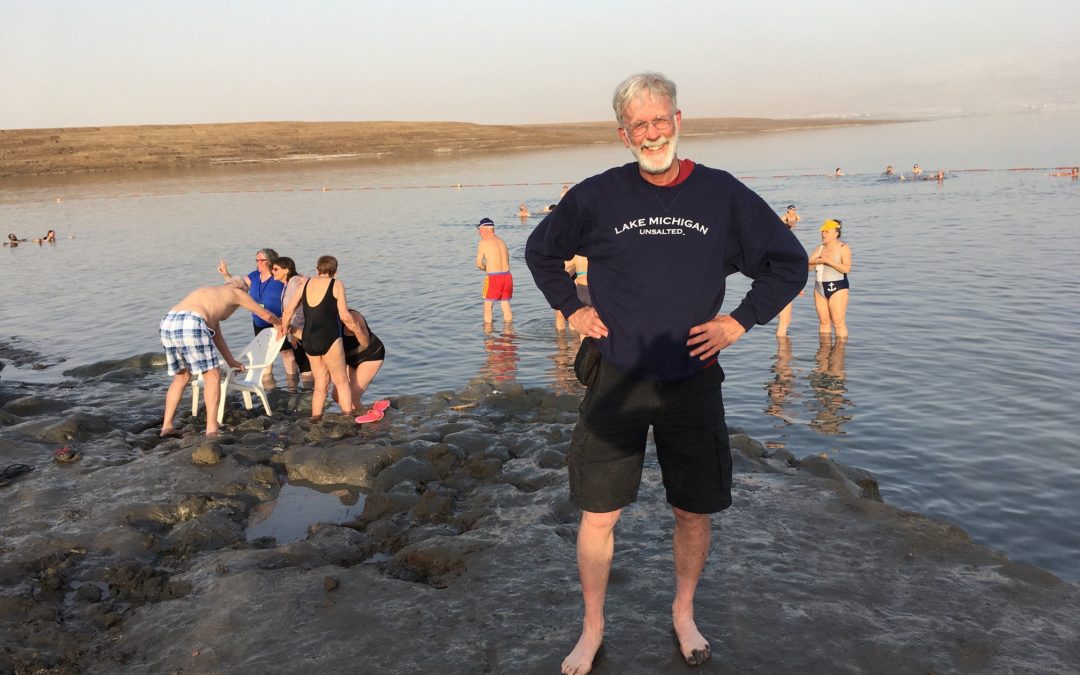
I couldn’t resist wearing my “Lake Michigan Unsalted” sweatshirt in the saltiest water in the world.
Walking into the Dead Sea is like trying to walk across a polished floor in roller skates.
When I arrived at the Dead Sea in Israel this past March, I figured I would simply stroll across a sandy beach and stride into the saltiest body of water in the world. Nothing to it, right? I didn’t realize that the Dead Sea’s “beach†was really more of a rock-hard slab slathered with a thin layer of mud—and as slick as ice.
I took one step toward the Dead Sea, slipped, and thought I was going to break my neck, which would’ve given new meaning to the “dead†in Dead Sea.
Fortunately, I kept my balance—but barely. Meanwhile, my wife found it equally treacherous, so she decided to splash around in a puddle located about five feet from the water’s edge. I dubbed it the Dead Sea Puddle, but don’t look for it in your guidebook. Both of us eventually managed to wobble our way from the Dead Sea Puddle to the Dead Sea itself, and we wound up wading in one of the most famous bodies of water on the planet.
The Dead Sea contains 33-percent salt, making it roughly nine times saltier than the ocean. Because it is the saltiest body of water in the world, people do not sink in it, although I wouldn’t know from first-hand experience. After all of the warnings, I opted not to float. Our tour guide warned us about getting salt water in open cuts, he warned us about the risks of swallowing the water, and he said that if we didn’t dry out our swim suits properly, it would make everything in our suitcases stink to high heaven.
I wasn’t thrilled by the idea of carrying a smelly Dead Sea Suitcase through a crowded airport, attracting unhappy stares from people all around us, so we stuck to wading.
The Dead Sea is south of Jerusalem, where the landscape turns dramatically brown and barren—beautiful in its own way. But with so much salt, nothing can live in its water, except for hardy microscopic creatures and perhaps my Uncle Horville. Hence the name, Dead Sea.
The Sea of Galilee, where Jesus based much of his ministry, is in the northern part of this small country, and the difference is striking. Because we visited Israel in the spring, everything around the Sea of Galilee was lush. The grass was as green as Ireland, and flowers sprouted up everywhere. A world apart from the Dead Sea.
The Jordan River flows into the Sea of Galilee from the north, and then it flows out of it in the south, winding its way down to the Dead Sea. But that’s where the water reaches a dead end—pun intended. In contrast to the Sea of Galilee, there is no outlet from the Dead Sea. Water flows into it, but does not flow out of it.
And that, in a nutshell, is why it is so salty.
In most lakes, water flows out, carrying away minerals. But because water does not flow out of the Dead Sea, the salt doesn’t leave. It just builds and builds and builds, and the incredible amount of salt makes it impossible for fish to live there.
Some preachers use the Dead Sea as a picture of a self-centered life. The Dead Sea receives water from the Jordan River, but it doesn’t send out water. It takes, but it doesn’t give, and the result is death and barrenness. The same thing happens if you live your life only for yourself. If you only take, but never give to others, your life becomes as lifeless as the Dead Sea.
This is also what makes the image of the Dead Sea in Ezekiel 47:1-12 so remarkable. In this chapter, the prophet Ezekiel has a vision of the Dead Sea, and he says it teems with “large numbers of fish.†Ezekiel goes on to say, “Fishermen will stand along the shore; from En Gedi to En Eglaim there will be places for spreading nets. The fish will be of many kinds—like the fish of the Mediterranean.â€
Ezekiel even says fruit trees will spring up all along the Dead Sea, and their leaves will not wither and their fruit will not fail.
Hold on. This doesn’t sound like the Dead Sea we know and love. We spotted no trees, and it would’ve been a miracle if we found any fish. What gives? Why did Ezekiel suddenly see so much life in this lifeless place?
The answer is quite simple. In his vision, water from the Holy Temple of God flowed into the Dead Sea, giving it new life. Where fish once could not live, the water from the Temple suddenly turned it into a SeaWorld paradise. It’s the same in our lives. If we connect with God, if we let His streams of living water flow into our lives, we will be amazed. Our lives will bear fruit, like the trees along the water’s edge. Our Dead Sea existence will suddenly explode with life.
In John 7:37-38, Jesus declares, “Let anyone who is thirsty come to me and drink. Whoever believes in me, as Scripture has said, rivers of living water will flow from within them.†According to John, Jesus is talking about the Holy Spirit, which lives in us, like God in His Holy Temple. And these living waters will flow out from us, spreading life everywhere it touches.
God has a way with water. He uses it to cleanse us and nourish us and bring dead things to life. So drink up and drink deeply. Jesus is offering us so much more than a salty puddle. He’s offering us living water straight from His Holy Temple.
By Doug Peterson


